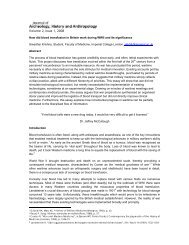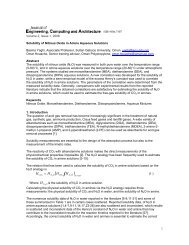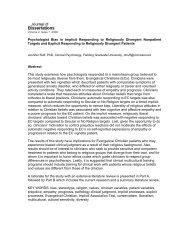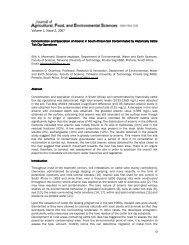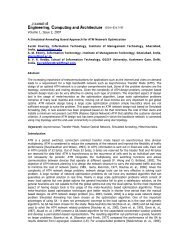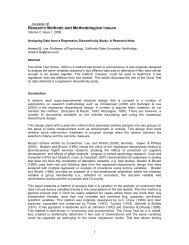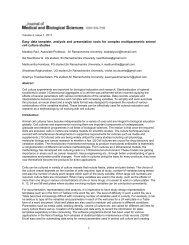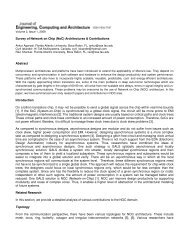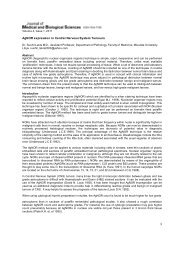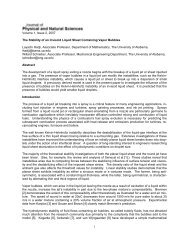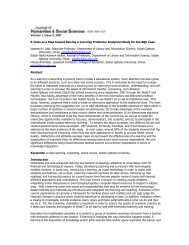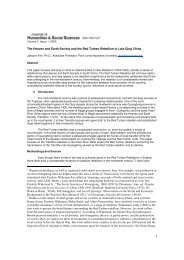1 Manora Island Project - Scientific Journals International.
1 Manora Island Project - Scientific Journals International.
1 Manora Island Project - Scientific Journals International.
You also want an ePaper? Increase the reach of your titles
YUMPU automatically turns print PDFs into web optimized ePapers that Google loves.
Volume 1, Issue 1, 2007<br />
<strong>Manora</strong> <strong>Island</strong> <strong>Project</strong>: a model primary care project in Pakistan<br />
Dr. Amin A. Muhammad Gadit, Discipline of Psychiatry, Memorial University of Newfoundland,<br />
St. John’s, NL A1B 3V6, Canada. E-mail: amin.muhammd@med.mun.ca<br />
Abstract<br />
This community based project which was established in an island of Karachi-Pakistan is a unique<br />
example of health care to a deprived community on a voluntary basis. It involves a group of<br />
dedicated medical doctors and social workers who surveyed a local community in the island with<br />
a population of n=5000, administered a questionnaire to assess their current health status along<br />
with the demographic information, provided on-site health services and reassessed their health<br />
status twice with a yearly interval and found that there was a significant decline in the morbidity of<br />
the local residents. It was concluded that if such projects are replicated nation-wide, the country’s<br />
health services will have tremendous improvement.<br />
Key words: community health, morbidity patterns, health indicators, poverty and health.<br />
Introduction<br />
Pakistan is a developing country in South Asia with a population of 165,803,560. The<br />
demographic information shows: annual growth rate of 2.09%, with population age structure of 0-<br />
14 (39%), 15-64 (56.9%), 65 years and over (4.1%), 1.05 male(s)/female, infant mortality rate of<br />
70.45 deaths/1,000 live births, life expectancy at birth of 62.4 years for males and 64.44 years for<br />
females.<br />
1
There is a low literacy rate and a large number of people believe in supernatural things as a<br />
cause of their ill health and therefore seek help from shamans and other alternate practitioners 1 .<br />
The average annual income of the individuals is US $ 630 and the country has suffered from<br />
decades of political disputes, violence, terrorism, lawlessness, problems with safety and security<br />
which has lead it towards economic problems, rising poverty, joblessness and on top of that the<br />
significant economic disparity 2 . Because of the current foreign aid, the economy of government<br />
has improved but still more than 39% of population lives below poverty line. The health care<br />
facilities include 946 hospitals, 4554 dispensaries, 5290 Basic Health Units and sub health<br />
centers, 907 Mother and Child Health Centers, 552 Rural Health Centers and 289 TB Centers<br />
primarily run by provincial governments. There are 100131 doctors registered with the Medical<br />
Council and 18029 specialists. There is output of around 5000 medical graduates from both<br />
public and private medical colleges. The government health care system has not been fully<br />
structured and is deficient 2 . Most of the basic and rural health centers are devoid of facilities and<br />
doctors. Of late there is a huge problem with brain drain, which is further weakening the health<br />
care system of the country 3 . Without the support of private sector, the health care for masses<br />
would have remained far from satisfactory. There are many places in the country where a wellstructured<br />
primary health care system is non-existent. <strong>Manora</strong> is an island adjacent to Karachi on<br />
the Arabian Sea with a population of 25000. In this <strong>Island</strong> the health facilities were almost<br />
nonexistent and people have to travel a lot with a cost, which they were not able to afford to reach<br />
the health services. There were only six general practitioners available for few hours in a day. For<br />
this reason community heavily rely on seeking health care from spiritual healers 4 .<br />
The Hamdard University Hospital of Hamdard University, with the help of some philanthropists<br />
and a pharmaceutical company, established the <strong>Manora</strong> health project in year 2000. The overall<br />
objective of this project was to provide basic preventive and curative health services to the<br />
deprived community of <strong>Manora</strong> <strong>Island</strong> with special emphasis on mental health services. A clinic<br />
was established on the island which was equipped to conduct the daily outpatient services for<br />
about 50-100 patients, a lady health visitor, medical administrator, nurse, social worker and a<br />
physician were appointed. A panel of specialists was formed who saw patients on different days<br />
in a week. Medical care was provided in the clinic along with health education and a community<br />
follow up arrangement through the health visitor was initiated.<br />
The functional structure of the project is outlined below:<br />
A flow diagram shows the structure of the project<br />
Hamdard<br />
University<br />
Hamdard College of Medicine & Dentistry<br />
Hamdard University Hospital<br />
Dept of psychiatry<br />
2<br />
<strong>Manora</strong> Health Center
Referral System<br />
Field team<br />
Center<br />
Patient Turnover<br />
50 – 100 per OPD<br />
Consultation (free)<br />
Medicines (free)<br />
Investigation (free)<br />
Funding Resources<br />
• Philanthropists<br />
• Pharmaceuticals<br />
• Hamdard Foundation<br />
Follow up<br />
Admission in Hamdard<br />
University Hospital<br />
(if necessary)<br />
Method<br />
A first baseline survey was conducted to assess the basic needs and prevalent health problems<br />
in the local community of <strong>Manora</strong>. The initial interaction with the community was made possible<br />
through community leaders’, social workers, and political agents. The team comprising of doctors,<br />
social workers and community health workers in order to ascertain the general health problems of<br />
the community conducted a general house-to-house survey. A total of 5000 residents were<br />
surveyed which is the total number of population of Sualeh Abad located at <strong>Manora</strong>. After the<br />
baseline survey, a questionnaire was developed inquiring about the demographic features, the<br />
present illness, compliance with the medications and follow up progress. This questionnaire was<br />
applied each time the patient visited the community health center. At the interval of one year, a<br />
community survey was conducted and morbidity pattern was recorded, later at the end of second<br />
year, the survey was repeated. The data was recorded systematically and analyzed. During the 2<br />
years period of involvement, training skills were provided to selected members of the community,<br />
as the male members who were deciding members for health seeking but remained away for<br />
fishing, the female members were encouraged to take decisions regarding their health matters.<br />
This was achieved through multiple focus group meetings and health education programs. This<br />
study is thus a mix of cross-sectional as well as intervention type.<br />
3
Results<br />
The survey findings showed that majority 97% of the population was Muslim. The literacy rate<br />
was found only18% and the most spoken languages were Sindhi and Urdu. Majority of people<br />
belong to the poor income group with average income of the household 2000 rupee. By<br />
profession 90% were fisherman and have their earning in only fishing season.<br />
The project started in beginning of year 2000 and at the end of third year in 2002 the evaluation<br />
showed remarkable progress and the common prevalent problems came down as shown in<br />
figure: 1 the decline in various communicable and non-communicable diseases in three years<br />
period of time. The respiratory disorders decline from 42% to 16%, GIT from 37% to 26%, skin<br />
disorder from 59% to 20%, eye problems from 12% to 5%. Regarding chronic diseases the<br />
cardiac problem rose from 2% to 4%. The problems related to gynecology and obstetrics were<br />
reduced from 30% to 17% and pediatric problems from 40% to 16% and the frequency of mental<br />
health problems were also lowered as shown in figure: 2 showed the mental health problems<br />
including; depression decline from 11% to 4%, psychosomatic disorders from 3% to 2%,<br />
substance abuse from 2% to 1% while schizophrenia and seizure disorder remained same that is<br />
1%.<br />
70<br />
Figure 1: Decline in Morbidity Pattern through a model community project of <strong>Manora</strong><br />
<strong>Island</strong> <strong>Project</strong>:<br />
60<br />
50<br />
40<br />
30<br />
20<br />
10<br />
0<br />
2000 2001 2002<br />
ARI GIT Skin Eye Cardiac Obs/gynae Paeds<br />
4
Figure one showed the decline in various communicable and non-communicable diseases in<br />
three years period of time. The respiratory disorders decline from 42% to 16%, GIT from 37% to<br />
26%, skin disorder from 59% to 20%, eye problems from 12% to 5%. Regarding chronic diseases<br />
the cardiac problem rose from 2% to 4%. The problems related to gynecology and obstetrics<br />
were reduced from 30% to 17% and pediatric problems from 40% to 16%.<br />
Figure 2 Decline in Mental health problems through a model community project of <strong>Manora</strong><br />
<strong>Island</strong> <strong>Project</strong>.<br />
12<br />
10<br />
8<br />
6<br />
4<br />
2<br />
0<br />
2000 2001 2002<br />
Depression<br />
Seizure<br />
Substance abuse<br />
Schizophrenia<br />
Psychosomatic disorder<br />
Figure 2 showed the mental health problems including; depression decline from 11% to 4%,<br />
psychosomatic disorders from 3% to 2%, substance abuse from 2% to 1% while schizophrenia<br />
and seizure disorder remained same that is 1%.<br />
In addition to this, the team was successful in promoting increase in self-reliance, self-awareness<br />
and confidence, self-examination and identification of problems, seeking solutions and associated<br />
behavioral changes.<br />
5
Discussion<br />
There is a rising global trend for community oriented primary care, which has played an important<br />
role in health care systems in many parts of the world. Community Oriented Primary Care<br />
(COPC) has provided a steady, provocative, and positive influence on global health services<br />
delivery. 5<br />
Current concepts of “population health” based on health maintenance organizations argue that<br />
practitioners need to have broad views of the health trends and demographic characteristics of<br />
the populations they serve even when practicing with individual patients. Managing care in any<br />
system with limited resources requires that practitioners have some sense of disease patterns,<br />
costs, and benefits – not just for individual patients but for the entire cohort of patients and, when<br />
a practice is the major provider of care in an area, for the community as a whole. 5<br />
COPC appeals on a principled level because it envisions community participation in health care<br />
decisions. COPC creates opportunities for consumers to participate in decision-making about<br />
health care delivery. 5<br />
In developing countries like Pakistan, there is an increasing need for strengthening and improving<br />
Primary Health Care.<br />
This has proved to be a model project by virtue of its ability to bring down the morbidity pattern of<br />
the island to an appreciable level. If this model is replicated nationally, the health scenario will<br />
show tremendous improvement. This project is in-line with a South African project, which brought<br />
about changes in a local Zulu community. 6<br />
There are few examples of community based primary care projects in the countries of Asia-<br />
Pacific region which are comparable with the study project. A report 7 from Bangla Desh describes<br />
a project as a case study which demonstrates the program’s ability to mobilize and engage local<br />
population in their own welfare development and identifies new roles for paramedics and<br />
community participation. Another report 8 from the same country demonstrates success in<br />
changing the health status of the given population showing improvement in crude birth rate, infant<br />
mortality rate, maternal mortality rate etc. thus identifying community participation as main pillar<br />
for primary health care development. Health education component in our study is similar to the<br />
Asia Burma <strong>Project</strong> on health. 9<br />
Community participation has been recognized as an important feature of successful community<br />
10, 11<br />
projects in studies conducted in Cambodia and Indonesia. The Prem Jyoti Community<br />
Hospital project 12 works towards strengthening the community, capacity building and intervention<br />
in specific areas. The Alor Community Based Health <strong>Project</strong> 13 in Indonesia has attempted to<br />
create a community-based focus for its activity and strengthen the capacity of community to<br />
understand and engage in formal health system. It narrates that when local community traditions,<br />
language, culture, religion and people are brought together into planning and activity then by<br />
virtue of community acceptance, participation and ownership the planning can go a long way in<br />
promoting good health of the community.<br />
Primary health care is one important approach among the alternative approaches to meeting<br />
basic health needs in developing countries. Worldwide, increasing recognition of the failure of<br />
existing health services in providing health care resulted in alternative ideas and methods, which<br />
are considered and tried 6, 14, 15 . Primary care projects played its important role in alleviating the<br />
inequalities in delivery of health care systems while remaining the backbone of health care<br />
system and became a source for continuous help in improving the health and development of<br />
poor population of the remote areas. People in Pakistan have grown healthier over the past three<br />
decades but health indicators have been improving very slowly. There is great need to focus on<br />
the basic health problems in the country. Primary health care is the best solution to overcome the<br />
health problems in Pakistan and to make it successful, joint collaboration of public and private<br />
6
health sector is required. Politicians should be sensitized towards health indicators of Pakistan.<br />
Communities should be mobilized towards self-help basis and sustainability in achieving their<br />
maximum health productivity. Primary health care services, as an individual’s first level of contact<br />
with the national health system, should be designed to bring health care as close to where people<br />
live and work. Building on primary health care, health system should be community based and<br />
comprehensive, available continuously, adequately financed, closely linked at all levels with<br />
social and environmental services and integrated into a wider referral system 16 . Health<br />
education has been proven to be of significant value in improving the health scenario of<br />
individuals and communities 17,18. This project-related study is giving an example of how the<br />
continuous rapport with the community and ongoing health education programmes can help in<br />
raising awareness to the extent that it becomes apparent on morbidity patterns. This project has<br />
now been shifted to another island where the clinic is converted into a state-of-art hospital<br />
catering for a community of 10,000 people. There are always some hurdles which is faced when<br />
embarking on such projects like government permissions and vested interest of local politicians.<br />
Such problems were faced by the organizers initially. Such types of projects are replicated in few<br />
other parts of the country on a lower scale.<br />
Conclusion<br />
This community health project is a model example, which has demonstrated the effect of health<br />
education in bringing down the morbidity pattern of diseases in a community. Keeping in mind,<br />
the bleak health care situation of Pakistan, such types of projects if replicated nation-wide can<br />
bring a significant change in the existing health scenario of the country.<br />
References<br />
1. Demographics of Pakistan: www.answers.com/topic/demographics-of-pakistan: date<br />
accessed: 5 th December, 2006.<br />
2. 10 th Five Year Plan, Health and Nutrition: Government of Pakistan, 2006, p: 178-181.<br />
3. Gadit, A. Impact of international recruitment of psychiatrists on the health system of<br />
Pakistan. J Coll Phys Surg Pak, 2006, vol 16(7), p: 441-444.<br />
4. Gadit A, “A preliminary report on an ongoing anthropological study”, Jr Coll Phys<br />
Surg Pakistan, Vol. 12, No. 3, 2002, pp: 195-196.<br />
5. F Mullan, Epstein L, “Community Oriented Primary Care: New relevance in changing<br />
world”, Am Jr of Public Health 2002, Vol. 92, No. 11.<br />
6. Greiger HJ, “Community Oriented Primary Care: A path to community development”,<br />
Am J Public Health, 2002, 92(11): 1713-6.<br />
7. J. Briscoe. Are voluntary agencies helping to improve health in Bangladesh? Int J<br />
Health Serv, 1980; 10(1): 47-69.<br />
8. www.whoban.org/health_system_bangladesh.html date accessed: 5/1/2007.<br />
9. www.burmaguide.net/re_en/BIG6_60_en/ 5/1/2007.<br />
10. Jacobs, B., Price, N. Community participation in externally funded health projects.<br />
Lessons from Cambodia. Health policy and Planning, 2003, 18(4):339-410.<br />
11. www.chata.org.an/printdocs/indonesia projectupdate_print.htm date accessed:<br />
15/1/2007.<br />
12. www.emms.org/programmes/article.php? Article ID=17 date accessed: 5/1/2007.<br />
13. www.engagingcommunities2005.org/abstracts/S20-newmarch_wa.html date<br />
accessed: 5/1/2007.<br />
14. Newell, KW et al. Health by the people 1975, WHO Geneva.<br />
15. Djukanovic V and Mach E P. Alternative approaches to meeting needs in developing<br />
countries, a joint UNICEF/WHO study 1975, WHO, Geneva.<br />
16. ICMR and ICSSR. Health for All strategy 1981, Indian Institute of Education, Pune.<br />
17. Pawloski, S., Gromedecka-Sutkiewicz, M., Skommer, J., Paul, M., Rokossowski, H.,<br />
Suchoka, E., Schantz, P.M. Impact of health education on knowledge and prevention<br />
7
ehavior for congenital toxoplasmosis: the experience in Poznan, Poland. 2002,<br />
Health Education Research, vol 16, No. 4, 493-502.<br />
18. Edwards, T., Cumberland, P., Hailu, G., Todd, J. Impact of Health Education on<br />
Active Trachoma Hyperendemic Rural Communities in Ethiopia. Ophthalmology.<br />
2006, Vol 113, issue 4, p: 548-555.<br />
8



